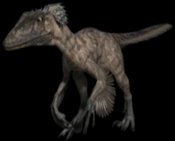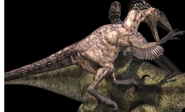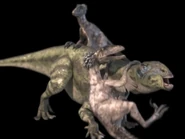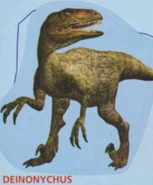Deinonychus (meaning “terrible claw”) was a dinosaur that appeared in the app Walking with Dinosaurs: Inside Their World - Narrated by Steven Fry and was mentioned in The Complete Guide To Prehistoric Life.
Facts[]
Deinonychus, meaning terrible claw, (/daɪˈnɒnɨkəs/ dy-NON-i-kəs; Greek: δεινός, 'terrible' and ὄνυξ, genitive ὄνυχος 'claw') is a genus of carnivorous dromaeosaurid dinosaurs. There is one described species, Deinonychus antirrhopus. These dinosaurs, which could grow up to 4 meters (13 ft) long, lived during the early Cretaceous period, about 130,000,000-95,000,000 BCE (from the mid-Aptian to early Albian stages). Fossils have been recovered from the U.S. states of Montana, Wyoming, and Oklahoma, in rocks of the Cloverly Formation and Antlers Formation, though teeth that may belong to Deinonychus have been found much farther east in Maryland.
Paleontologist John Ostrom's study of Deinonychus in the late 1960s revolutionized the way scientists thought about dinosaurs, leading to the "dinosaur renaissance" and igniting the debate on whether dinosaurs were warm-blooded or cold blooded. Before this, the popular conception of dinosaurs had been one of plodding, reptilian giants. Ostrom noted the small body, sleek, horizontal posture, ratite-like spine, and especially the enlarged raptorial claws on the feet, which suggested an active, agile predator.
"Terrible claw" refers to the unusually large, sickle-shaped talon on the second toe of each hind foot. The fossil YPM 5205 preserves a large, strongly curved ungual. In life, archosaurs have a horny sheath over this bone, which extends the length. Ostrom looked at crocodile and bird claws and reconstructed the claw for YPM 5205 as over 120 millimetres (4.7 in) long.
The species name antirrhopus means "counter balance", which refers to Ostrom's idea about the function of the tail. As in other dromaeosaurids, the tail vertebrae have a series of ossified tendons and super-elongated bone processes. These features seemed to make the tail into a stiff counterbalance, but a fossil of the very closely related Velociraptor mongoliensis (IGM 100/986) has an articulated tail skeleton that is curved laterally in a long S–shape. This suggests that, in life, the tail could bend to the sides with a high degree of flexibility.
In both the Cloverly and Antlers formations, Deinonychus remains have been found closely associated with those of the ornithopod Tenontosaurus. Teeth discovered associated with Tenontosaurus specimens imply they were hunted, or at least scavenged upon, by Deinonychus.
Deinonychus is thought to have hunted by leaping onto prey and clawing them to death. They were thought to have hunted in packs, kick-starting the popular notion that raptors were pack animals. The evidence isn't completely solid yet.
Walking with Dinosaurs: Inside Their World[]
Deinonychus is one of the viewable dinosaurs in this app.
Gallery[]
Appearance in other media[]
Raptor Red[]
Deinonychus is one of the dinosaurs featured in this novel.
Jurassic Fight Club[]
The episode "Gang Killer" was featured on Deinonychus and its predator-prey relationship with Tenontosaurus.
Jurassic Park[]
Read more at the Jurassic Park Wiki
|







